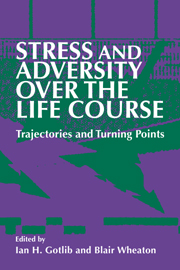Book contents
- Frontmatter
- Contents
- List of contributors
- 1 Trajectories and turning points over the life course: concepts and themes
- I Trajectories: long-term effects of adverse experience
- II Turning points: changes in life trajectories
- 8 Becoming unsupervised: children's transitions from adult-care to self-care in the afterschool hours
- 9 Children whose parents divorce: life trajectories and turning points
- 10 Life after high school: development, stress, and well-being
- 11 Turning points in midlife
- 12 Adaptation to retirement
- III New methods for the study of the life course
- Index
9 - Children whose parents divorce: life trajectories and turning points
from II - Turning points: changes in life trajectories
Published online by Cambridge University Press: 23 October 2009
- Frontmatter
- Contents
- List of contributors
- 1 Trajectories and turning points over the life course: concepts and themes
- I Trajectories: long-term effects of adverse experience
- II Turning points: changes in life trajectories
- 8 Becoming unsupervised: children's transitions from adult-care to self-care in the afterschool hours
- 9 Children whose parents divorce: life trajectories and turning points
- 10 Life after high school: development, stress, and well-being
- 11 Turning points in midlife
- 12 Adaptation to retirement
- III New methods for the study of the life course
- Index
Summary
The divorce of one's parents can be a crucial and formative experience with powerful impact on the rest of one's life. Time and time again, retrospective reports focus on divorce as a “turning point” in the life of a family and its individual members (Clausen 1990). The experience of parental divorce is part of the fabric of life for significant numbers of U.S. children, with estimates suggesting that 30% to 50% will see their parents’ marriages end. The divorce rate for remarried couples (49%) is slightly higher than the divorce rate for first marriages (47%); thus, many children experience divorce repeatedly (Crosbie-Burnett 1994). In addition, there is mixed evidence concerning the beneficial or ameliorative effects of parental remarriage for children (Zill, Morrison, & Coiro 1993) and ample evidence that – whether in a single-parent home or a remarried/stepparent home – children whose parents have divorced exhibit more behavior problems and lower levels of social competency than children from “intact” homes (Hetherington & Clingempeel 1992).
“Demographers who try to portray the family experiences of children are scratching their heads, wondering how to capture the complex life courses that many children born in the 1980s and 1990s will follow” (Furstenberg & Cherlin 1991, p. 12). Although there is some suggestion of a stabilization or even a decline in the rate of divorce in the 1990s, the influences of divorce experiences pervade contemporary life and figure centrally in most analyses of child and adult health and well-being.
- Type
- Chapter
- Information
- Stress and Adversity over the Life CourseTrajectories and Turning Points, pp. 179 - 196Publisher: Cambridge University PressPrint publication year: 1997
- 11
- Cited by



